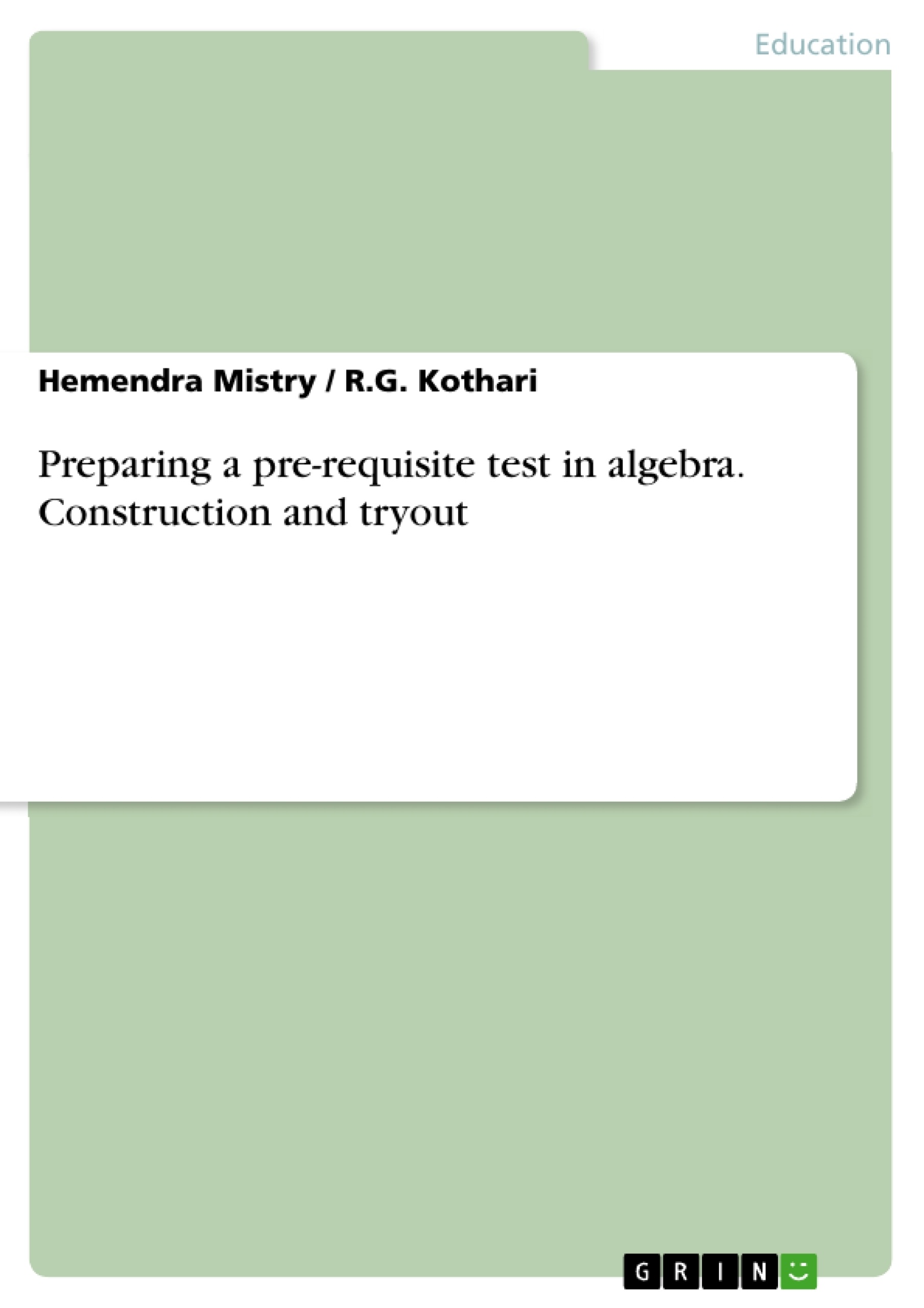Mathematics is an important discipline of learning at the secondary stage. It predominantly contributes to the development of precision, rational and analytical thinking, reasoning and scientific temper. One of the basic aims of teaching Mathematics at secondary stage is to inculcate the skill of quantification of experience gathered by the learner. But still some of the students find Mathematics as very difficult subject.
Among different branches of Mathematics, Algebra is used to enable the learner to apply its knowledge to other branches of Mathematics. The pre-requisite test can help the students to know their weaknesses in the basic concepts and it also helps the teachers to know the level of their students.
The authors had constructed a pre-requisite test covering all units of Algebra of standard X and implemented on the randomly selected standard X students of the twelve non-granted Gujarati medium schools of Vadodara, Gujarat, India. Based on the findings of the study, the authors discussed and suggested some ways for the teachers teaching Mathematics at secondary school level.
Inhaltsverzeichnis (Table of Contents)
- PREFACE
- CONTENTS
- LIST OF TABLES
- LIST OF GRAPHS
- CHAPTER I: COCEPTUAL FRAMEWORK
- 1.1 INTRODUCTIN
- 1.2 THE PLACE OF MATHEMATICS IN SCHOOL CURRICULUM
- 1.2.1 The Place of Mathematics at Secondary Stage
- 1.3 OBJECTIVE OF TEACHING OF MATHEMATICS
- 1.4 CONCEPT OF ALGEBRA
- 1.4.1 Importance of Algebra
- 1.4.2 Objective of Teaching Algebra
- 1.5 MATHEMATICAL WEAKNESSES
- 1.6 RATIONALE OF THE STUDY
- 1.7 RESEARCH QUESTIONS
- 1.8 STATEMENT OF THE PROBLEM
- 1.9 OBJECTIVES OF THE STUDY
- 1.10 EXPLANATION OF THE TERMS USED
- 1.11 DELIMITATION OF THE STUDY
- CHAPTER II: REVIEW OF RELATED LITERATURE
- 2.1 INTRODUCATION
- 2.2 REVIEW OF RELATED LITERATURE
- 2.2.1 Studies related to Diagnosis and Remediation in Mathematics
- 2.2.2 Studies related to Achievement in Mathematics
- 2.2.3 Studies related to Achievement in Algebra
- 2.2.4 Studies related to Pre-requisite Tests in Mathematics
- 2.3 IMPLICATION OF REVIEW OF RELATED LITERATURE
- CHAPTER III: RESEARCH METHODOLOGY
- 3.1 INTRODUCTION
- 3.2 METHODOLOGY
- 3.2.1 Research Methodology
- 3.2.2 Population of the Study
- 3.2.3 Sample of the Study
- 3.3 TOOLS FOR DATA COLLECTION
- 3.3.1 Achievement test
- 3.3.2 Pre-requisite Test
- 3.4 DATA COLLECTION
- 3.5 DATA ANALYSIS
- 3.5.1 Analysis of Achievement Test
- 3.6.2 Analysis of Pre-requisite Test
- CHAPTER IV: DATA ANALYSIS AND INTERPRETATION
- 4.1 INTRODUCTION
- 4.2 ANALYSIS OF FOUR ACHIEVEMENT TESTS
- 4.2.1 Chapter I: Linear Equation in Two Variables
- 4.2.2 Detailed Analysis of Items for Chapter I: Linear Equation in two Variables
- 4.2.3 Chapter II: H.C.F and L.C.M of Polynomials
- 4.2.4 Detailed Analysis of Items for Chapter II: H.C.F and L.C.M of Polynomials
- 4.2.5 Chapter III: Rational Expressions
- 4.2.6 Detailed Analysis of Items for Chapter III: Rational Expressions
- 4.2.7 Chapter IV: Quadratic Equation
- 4.2.8 Detailed Analysis of Items for Chapter IV: Quadratic Equation
- 4.2.9 Summary of Basic Concepts where Errors occur
- 4.3 MEAN AND STANDARD DEVIATION OF PRE-REQUISITE TEST
- 4.4 ANALYSIS OF PRE-REQUISITE TEST
- 4.4.1 Item-wise Analysis of Pre-requisite Test
- CHAPTER V: MAJOR FINDINGS, DISCUSSION AND SUGGESTION
- 5.1 INTRODUCTION
- 5.2 MAJOR FINDINGS OF THE STUDY
- 5.2.1 Findings of Achievement Test
- 5.2.2 Findings of Pre-requisite Test
- 5.3 DISCUSSION
- 5.4 SUGGESTION FOR THE TEACHERS
- 5.5 SUGGESTION FOR FURTHER STUDY
- BIBLIOGRAPHY
- APPENDICES
Zielsetzung und Themenschwerpunkte (Objectives and Key Themes)
This research aims to assess the pre-requisite knowledge of standard X students in algebra and identify areas where students struggle. The study seeks to understand the reasons behind these difficulties and provide suggestions for teachers to improve student learning in algebra.
- The importance of mathematics in education, particularly at the secondary level.
- The role of pre-requisite tests in identifying student learning gaps and informing teaching practices.
- The specific challenges students face in understanding and applying algebraic concepts.
- The development and implementation of a pre-requisite test in algebra for standard X students.
- Recommendations for improving the teaching and learning of algebra based on the research findings.
Zusammenfassung der Kapitel (Chapter Summaries)
Chapter I provides a conceptual framework for the study, discussing the importance of mathematics in education, the objectives of teaching mathematics, and the specific challenges students face in algebra. Chapter II reviews relevant literature on diagnosis and remediation in mathematics, achievement in mathematics and algebra, and the use of pre-requisite tests. Chapter III outlines the research methodology, including the population and sample of the study, data collection methods, and data analysis techniques. Chapter IV analyzes the data collected from the achievement tests and the pre-requisite test, identifying specific areas of difficulty for students. Chapter V presents the major findings of the study, discusses the implications of the results, and offers suggestions for teachers and future research.
Schlüsselwörter (Keywords)
The key themes and concepts explored in this research include pre-requisite knowledge, algebra, achievement in mathematics, student learning gaps, diagnosis and remediation, teaching practices, secondary education, and pre-requisite tests.
- Arbeit zitieren
- Hemendra Mistry (Autor:in), R.G. Kothari (Autor:in), 2012, Preparing a pre-requisite test in algebra. Construction and tryout, München, GRIN Verlag, https://www.grin.com/document/333985



